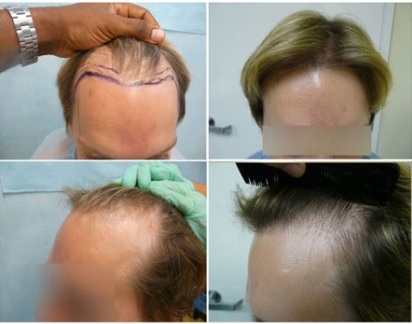
HAIR LOSS
Genetic hair loss, known as pattern baldness or androgenic alopecia, is known for causing permanent hairline loss and crown hair loss in men. Although dihydrotestosterone (DHT) has been identified as the follicle-miniaturizing hormone that shrinks scalp hair down to nothing, thus leading to eventual baldness, this is not where the condition starts. Pattern baldness originates in the X chromosomes of either the mother or father, carrying weak androgen receptors through the family lineage. So, only those who are genetically predisposed to pattern baldness should endure the destructive consequences of DHT.

HAIR RESTORATION
Hairline recession is reversible through hair transplant. This is currently the only means of restoration in this area, since non-surgical methods such as Propecia and Rogaine are only effective for crown loss. Today’s two leading methods of surgical hair restoration include follicular unit transplant (FUT), which is also known as strip harvesting, or follicular unit extraction (FUE).
FUT harvests donor hair by cutting the grafts out in the form of a linear strip of flesh. This hair-bearing flesh typically comes from the safe donor zone, which is the patient’s occipital scalp area. FUE harvests the grafts by cutting them out one at a time with a microscopic .8-1.2mm punch. The latter method results in less overall scarring and no linear scar due to its reduced invasiveness. It also provides the surgeon with a wider donor area to select from (i.e. nape or leg hair) for enhanced design.

Hairline Recession
Hairline recession is particularly difficult to treat because of the temperament of the area overall—changing frequently in the angulation and direction of hair placement as it flows into the temple points. The standard hairline is the area where naked forehead skin (the forehead being vertical and flat) meets the hair of the scalp (at which point the skeletal structure curves onto a horizontal plane). This line spans across the top of the face, from one side of the head to the other, where it adjoins with the temporal recesses on either side.
Considerations a surgeon must contemplate when performing hairline restoration include:
- Position of the hairline
- Shape of the hairline
- Density of the hairline
- Caliber/texture of the hairline
Taking into account certain factors like the Rule of Thirds, unique facial-skeletal anatomy, and the patient’s ethnic background, a surgeon starts to understand how to attack each individual case. Hairline recession is best treated by an experienced practitioner, and preferably a practitioner of FUE; lest the new hairline end up too sparse, asymmetrical, harsh and pluggy, overly aggressive, or some other miscalculated result.


PHOTOS AND VIDEOS OF HAIRLINE RECESSION
Photos and videos are paramount in choosing the right surgeon to perform your surgery. It goes without saying that you want a doctor who has years of experience working on hairlines. Someone whose success is reliable, someone who uses handheld tools in order to uphold the integrity of every graft selected, someone with the artistic vision to choose hairs that will be particularly flattering to the hairline.
You can garner the proof you need through scrutinizing photos and videos for graft placement, position, overall shape, and density. Images must not have been tampered with, edited, or retouched and should show the patient in focus, in good lighting, and from multiple angles.

FAQ
Are there other causes of hairline recession?
Typically loss along the hairline is a direct manifestation of pattern baldness. However, another notable cause of hairline loss is traction alopecia, common in African American women. Other causes of more diffuse hair loss, include malnourishment, severe stress, hormonal changes, diabetes, drug abuse, pregnancy, and thyroid problems.
How much does hairline restoration cost?
Hairline restoration using FUE typically costs between $5 and $12 per graft. And since the hairline doesn’t tend to require more than around a thousand grafts, it is a widely affordable procedure.

